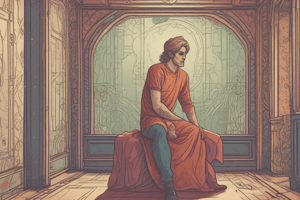Podcast
Questions and Answers
¿Cuál es el principal objetivo de las defensas obsesivas?
¿Cuál es el principal objetivo de las defensas obsesivas?
- La inhibición y el control de la agresión (correct)
- La expresión de la agresión
- La externalización de los sentimientos
- La búsqueda de unión y conexión con los demás
¿Cómo se presents la figura humana en estos dibujos?
¿Cómo se presents la figura humana en estos dibujos?
- Con cabello suelto y ropa adornada
- Como una figura completa y detallada
- Con rasgos faciales cambiantes
- Redimensionada, reducida a la cabeza (correct)
¿Qué función cumplen los globos y objetos grandes y vacíos en los dibujos?
¿Qué función cumplen los globos y objetos grandes y vacíos en los dibujos?
- Contrarrestar el sentimiento de vacío y carencia (correct)
- Simbolizar la libertad y la alegría
- Representar la abundancia y la riqueza
- Expresar la agresividad y la ira
¿Cuál es el resultado del aislamiento en estos dibujos?
¿Cuál es el resultado del aislamiento en estos dibujos?
¿Qué tipo de perspectiva se utiliza en la representación de la casa?
¿Qué tipo de perspectiva se utiliza en la representación de la casa?
¿Cuál es el papel del árbol en estos dibujos?
¿Cuál es el papel del árbol en estos dibujos?
¿Cuál es la función principal del tronco en la representación gráfica?
¿Cuál es la función principal del tronco en la representación gráfica?
¿Qué pueden indicar los brazos y manos en la representación gráfica?
¿Qué pueden indicar los brazos y manos en la representación gráfica?
¿Cuál es el significado de omitir o distorsionar los brazos y manos en la representación gráfica?
¿Cuál es el significado de omitir o distorsionar los brazos y manos en la representación gráfica?
¿Qué pueden indicar las manos omitidas o distorsionadas en la representación gráfica?
¿Qué pueden indicar las manos omitidas o distorsionadas en la representación gráfica?
¿Cuál es el significado del cuello alargado en la representación gráfica?
¿Cuál es el significado del cuello alargado en la representación gráfica?
¿Qué característica puede ser inferida si el tronco carece de detalles?
¿Qué característica puede ser inferida si el tronco carece de detalles?
¿Cuál de las siguientes características se puede inferir de una persona que dibuja un sendero largo y tortuoso hacia la casa?
¿Cuál de las siguientes características se puede inferir de una persona que dibuja un sendero largo y tortuoso hacia la casa?
¿Qué representa el tronco del árbol en el dibujo de la casa, el árbol y la persona?
¿Qué representa el tronco del árbol en el dibujo de la casa, el árbol y la persona?
¿Cuál de las siguientes características se puede inferir de una persona que rodea la casa con cercos?
¿Cuál de las siguientes características se puede inferir de una persona que rodea la casa con cercos?
¿Qué puede revelar el agregado de accesorios en el dibujo de la casa, el árbol y la persona?
¿Qué puede revelar el agregado de accesorios en el dibujo de la casa, el árbol y la persona?
¿Cuál de las siguientes características se puede inferir de una persona que dibuja un sendero ancho en el extremo del observador?
¿Cuál de las siguientes características se puede inferir de una persona que dibuja un sendero ancho en el extremo del observador?
¿Qué puede indicar la presencia de líneas periféricas reforzadas en el tronco del árbol?
¿Qué puede indicar la presencia de líneas periféricas reforzadas en el tronco del árbol?
Flashcards
Obsessive Defenses: Primary Goal
Obsessive Defenses: Primary Goal
The main goal of obsessive defenses is to inhibit and control aggression.
Human Figure Depiction in Drawings
Human Figure Depiction in Drawings
The human figure is often depicted as small, especially the head, highlighting the individual's feelings of inadequacy and lack of control.
Large, Empty Objects: Meaning in Drawings
Large, Empty Objects: Meaning in Drawings
Large, empty objects, such as balloons, in drawings represent an attempt to counteract feelings of emptiness and lack. These empty spaces symbolize a longing for connection and fulfillment.
Isolation in Drawings: Interpretation
Isolation in Drawings: Interpretation
Signup and view all the flashcards
Perspective in House Drawings: “Lomas Perspective”
Perspective in House Drawings: “Lomas Perspective”
Signup and view all the flashcards
Tree Representation in Drawings
Tree Representation in Drawings
Signup and view all the flashcards
The Trunk: Symbolism in Drawings
The Trunk: Symbolism in Drawings
Signup and view all the flashcards
Arms and Hands: Signifiers of Social Interaction
Arms and Hands: Signifiers of Social Interaction
Signup and view all the flashcards
Omitting or Distorting Arms and Hands: Meaning
Omitting or Distorting Arms and Hands: Meaning
Signup and view all the flashcards
Distorted Hands: Social Interaction Difficulty
Distorted Hands: Social Interaction Difficulty
Signup and view all the flashcards
Significance of an Elongated Neck in Drawings
Significance of an Elongated Neck in Drawings
Signup and view all the flashcards
Trunk with No Detail: Implications
Trunk with No Detail: Implications
Signup and view all the flashcards
Long, Winding Path in Drawings: Friendship Approach
Long, Winding Path in Drawings: Friendship Approach
Signup and view all the flashcards
The Tree Trunk: Inner Strength and Resilience
The Tree Trunk: Inner Strength and Resilience
Signup and view all the flashcards
Fences Surrounding the House: Interpretation
Fences Surrounding the House: Interpretation
Signup and view all the flashcards
Accessories: Task Execution and Approach
Accessories: Task Execution and Approach
Signup and view all the flashcards
Wide Path: Concealing Isolation
Wide Path: Concealing Isolation
Signup and view all the flashcards
Strong Lines on the Trunk: Preserving Identity
Strong Lines on the Trunk: Preserving Identity
Signup and view all the flashcards




